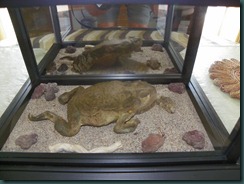I do have something of interest to share, however, as Bill Wrightson was out scouring the property on his usual early morning rounds and came across a Sonoran Desert Toad. Although deceased, the toad was a perfect speciman so Bill has it sealed in a display case.

As with anything I hadn’t seen before, I rushed off to the internet for some more information. Don’t let your puppy dog play with these toads!
In Arizona there are nine species of true toads, including the Sonoran Desert Toad which is also known as the Colorado River Toad. This toad is our largest species. It reaches 16 cm in length and is olive green with a white wart near the angle of the jaw.
Toads spend most of the year underground, having dug themselves in or usurped abandoned rodent burrows. Summer rains sufficient to wet the animals deep in their burrows triggers emergence and signal the beginning of breeding season.
These amphibians are preyed upon by snakes as well as other amphibians, but they are rather well protected against predation by mammals. The skin of the toad produces toxins that reacts with mucous. If a dog mouths a toad, it will suffer severe discomfort with the possibility of paralysis and death. In fact, if a toad sits in a dog's water dish for some period and the pet subsequently drinks the water, the dog can become ill, perhaps even die.
Hawks, owls and snakes prey upon the Sonoran Desert Toad.
After mating, toads feed on insects, spiders and smaller toads that are also made abundant by the summer rain. They will also eat small vertebrates. In fact, toads will attempt to eat anything of an appropriate size that moves. Even insects that fly are easy prey for the toad's quick flicking tongue. After storing an adequate supply of fat, toads again burrow into the ground where they overwinter.
